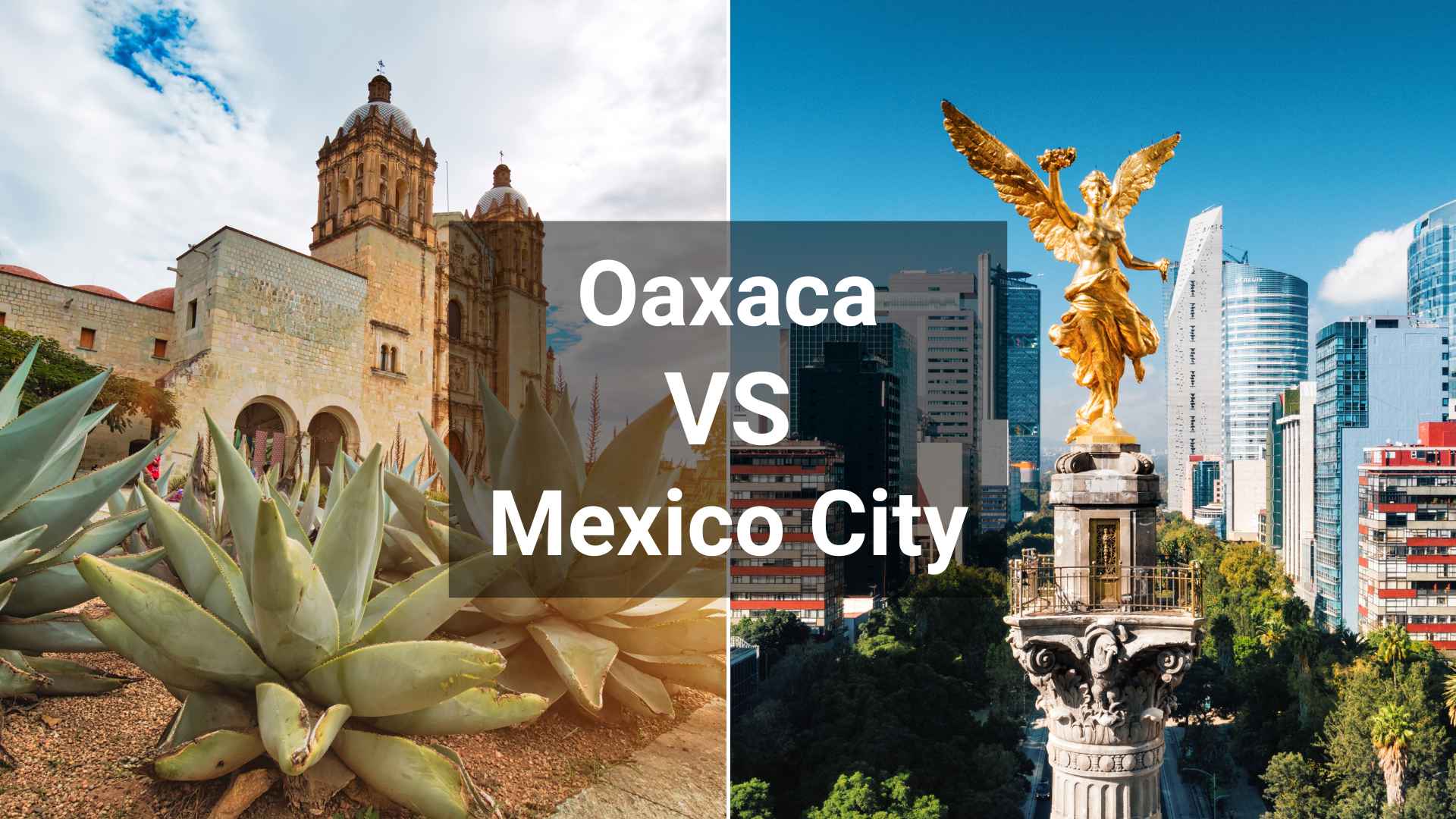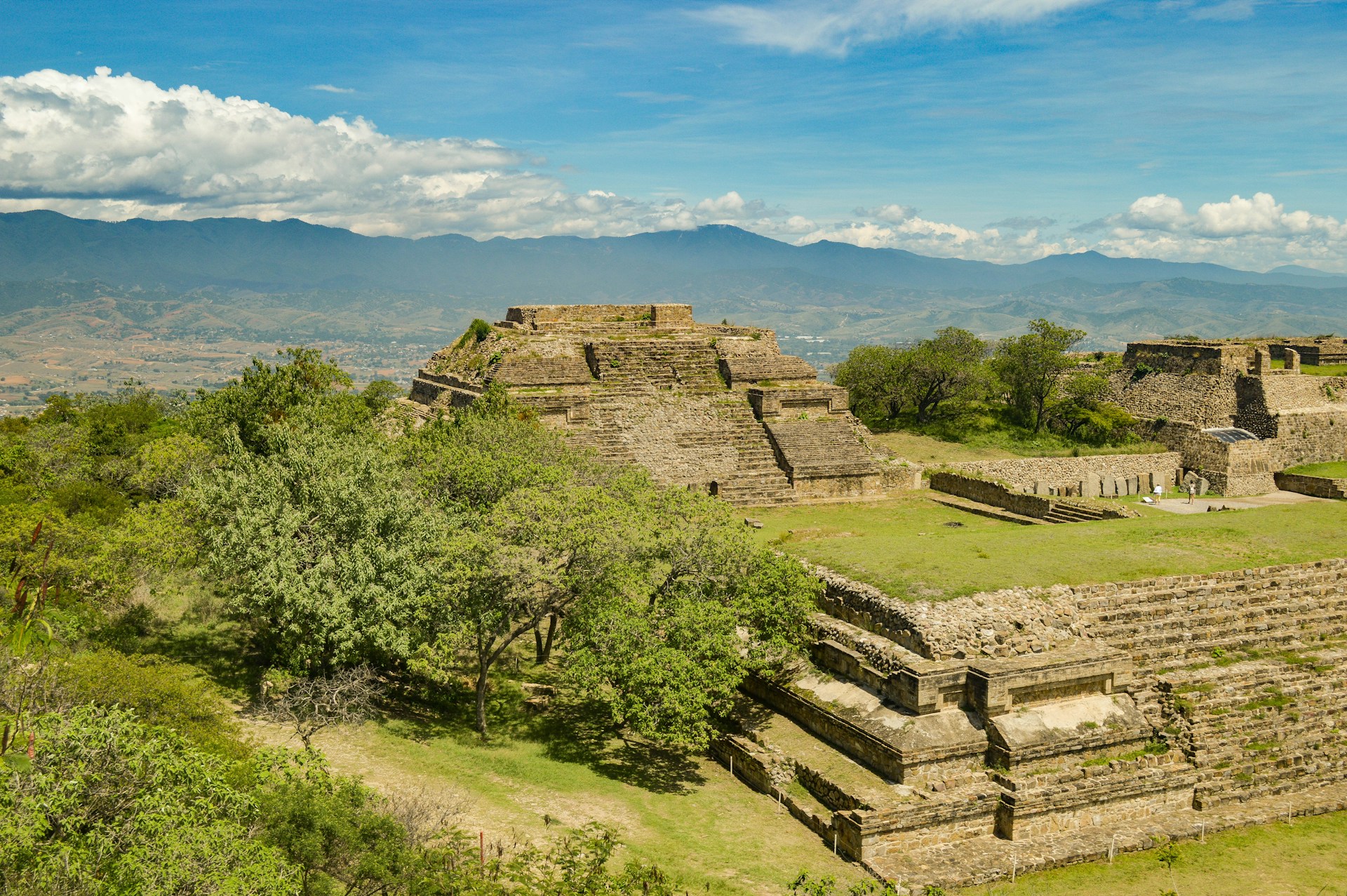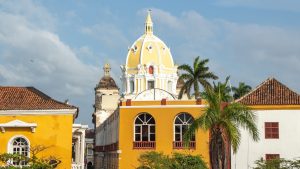Oaxaca vs Mexico City: A Tale of Two Mexican Gems
Mexico – a land of vibrant colors, tantalizing flavors, and rhythms that can make even the most reserved traveler tap their feet. In this exploration, we dive into two of Mexico’s most fascinating destinations: Oaxaca and Mexico City. Both are rich in culture and history, yet they offer distinctly different experiences. Let’s embark on a journey to uncover which city might just steal your heart (and possibly your stomach!).

Why visit Oaxaca?
Venturing into Oaxaca is like stepping into a vibrant tapestry woven with rich cultural threads, a place where tradition and modernity coalesce in a colorful embrace. This southern gem of Mexico is a haven for those seeking an immersive cultural experience. Oaxaca’s charm lies in its authenticity; it’s a region that proudly showcases its indigenous roots through every aspect – from the intricate weaves of its textiles to the complexity of its world-renowned cuisine. Oaxaca is not just a destination; it’s a sensory journey. The city’s cobbled streets are lined with colonial buildings in pastel hues, leading to bustling markets like Mercado Benito Juárez, brimming with local crafts and flavors. It’s a place where the aroma of mole, a culinary masterpiece with over 20 ingredients, fills the air.
But Oaxaca’s allure extends beyond its city limits. The surrounding valleys are sprinkled with archaeological wonders like Monte Albán, whispering tales of ancient civilizations. The region’s diverse landscape, ranging from misty mountains to tranquil beaches like Puerto Escondido, offers a retreat for every type of traveler. Oaxaca’s vibrant festivals, especially the famed Día de Muertos, are a spectacle of life, color, and tradition, providing a deeper understanding of Mexican heritage. Visiting Oaxaca is more than a trip; it’s an enriching encounter with the heart and soul of Mexico.
Why visit Mexico City?
Mexico City, a sprawling metropolis and the pulsating heart of modern Mexico, stands in striking contrast to the tranquil charm of Oaxaca. This city is a spectacular canvas of history, art, and urban energy, making it an irresistible destination for the culturally curious. Mexico City is an architect’s dream, where ancient Aztec ruins coexist with colonial palaces and cutting-edge modern structures. The city’s historic center, anchored by the Zócalo and the majestic Palacio de Bellas Artes, offers a journey through centuries in just a few steps.
But to understand Mexico City, one must dive into its neighborhoods. Each barrio tells its own story, from the bohemian vibes of Coyoacán, Frida Kahlo’s stomping grounds, to the upscale streets of Polanco, dotted with designer boutiques and gourmet restaurants. The city’s culinary scene is a tapestry of flavors, ranging from street-side taco stands to Michelin-starred establishments, showcasing the depth and diversity of Mexican cuisine.
Cultural immersion in Mexico City is inevitable, with its myriad museums, like the renowned Museo Nacional de Antropología, offering a glimpse into Mexico’s rich heritage. The city’s vibrant arts scene, bustling markets, and lush parks add layers of charm to its already fascinating character. In Mexico City, every corner hums with life, presenting a dynamic blend of tradition and modernity that captivates and enchants.
1. Oaxaca vs Mexico City: History and Culture
Oaxaca: Oaxaca is akin to a finely woven tapestry of indigenous cultures, most notably the Zapotecs and Mixtecs. Walking through Oaxaca’s streets, you’re greeted by colonial-era churches and indigenous art. The Monte Albán ruins are a must-visit for history buffs, showcasing ancient Zapotec civilization. And for a touch of the mystical, the Day of the Dead celebrations in Oaxaca are an ethereal experience unlike any other.
Mexico City: This sprawling metropolis is like a history book come to life. The Zócalo, Mexico City’s main square, is a testament to its layered history, where pre-Hispanic ruins rub shoulders with colonial architecture. The Frida Kahlo Museum and the Palace of Fine Arts offer glimpses into the artistic soul of Mexico. And let’s not forget the vibrant markets, like La Ciudadela, where the colors and crafts of Mexico come alive.
2. Oaxaca vs Mexico City: Culinary Delights
Oaxaca: Oaxaca is often hailed as the gastronomic heart of Mexico. It’s the birthplace of mezcal, the smoky spirit that’s gained international acclaim. The city’s markets are a wonderland of local ingredients, including the famed Oaxacan cheese and chocolate. Dishes like tlayudas (large tortillas with a spread of beans, cheese, and meat) and mole negro offer a taste of the region’s culinary richness.
Mexico City: Mexico City is a foodie’s paradise, where street food stands are culinary destinations in their own right. From tacos al pastor spinning on a vertical grill to the rich, complex flavors of mole, the city is a smorgasbord of tastes. High-end dining is also at its peak here, with innovative chefs like Enrique Olvera redefining Mexican cuisine.
3.Oaxaca vs Mexico City: Nature and Scenery - Breathtaking Landscapes vs Urban Jungle

Mexico City: While known for its urban sprawl, Mexico City is not without its natural wonders. The Chapultepec Park is a verdant oasis in the heart of the city, and the Floating Gardens of Xochimilco offer a unique ecological experience. However, nature lovers might find the city’s concrete jungle a bit overpowering.
Oaxaca: Oaxaca, on the other hand, is surrounded by natural beauty. The Sierra Norte mountains offer hiking and village-to-village trekking opportunities. The petrified waterfalls of Hierve el Agua are not just a natural wonder but also a great place for a refreshing dip. Nature in Oaxaca feels more accessible and integrated with daily life.
4. Oaxaca vs Mexico City: Nightlife and Entertainment
Mexico City: When the sun sets, Mexico City transforms. The nightlife here caters to every taste, from pulsating clubs in Zona Rosa to cozy jazz bars in Roma. Cultural events are plentiful, with live music, theater, and dance performances almost every night.
Oaxaca: Oaxaca’s nightlife is more subdued but no less charming. The evenings often start with a leisurely stroll down the pedestrian-friendly streets, followed by a nightcap of mezcal at a local bar. Cultural events, often centered around local traditions and holidays, provide a more laid-back form of entertainment.
5. Oaxaca vs Mexico City: Accessibility and Ease of Travel
Mexico City: As one of the largest cities in the world, Mexico City can be overwhelming. The metro system is extensive but crowded. Traffic can be a challenge, and the sheer size of the city means more time spent in transit. However, the city is well-connected by air, with direct flights from many international destinations.
Oaxaca: Oaxaca is smaller and more navigable. Its compact size means you can explore much of the city on foot. Public transport is less developed than in Mexico City, but taxis are affordable and plentiful. The city’s airport has fewer direct international flights, but connections through Mexico City are frequent.
6. Oaxaca vs Mexico City: Who Wins Your Travel Heart?
Both Mexico City and Oaxaca have their unique charm and appeal.
If you’re a history enthusiast or a foodie with a penchant for bustling urban environments, Mexico City’s dynamic pulse is for you. It’s a city where every corner tells a story and every meal is an adventure.
For those seeking a blend of cultural richness with a more relaxed pace, Oaxaca is a dream. Its indigenous heritage, coupled with stunning natural scenery and a laid-back atmosphere, makes it ideal for travelers looking for a more intimate experience with Mexican culture.
In the end, whether you’re drawn to the lively streets of Mexico City or the colorful corners of Oaxaca, both destinations promise an unforgettable journey into the heart of Mexico. ¡Buen viaje!



